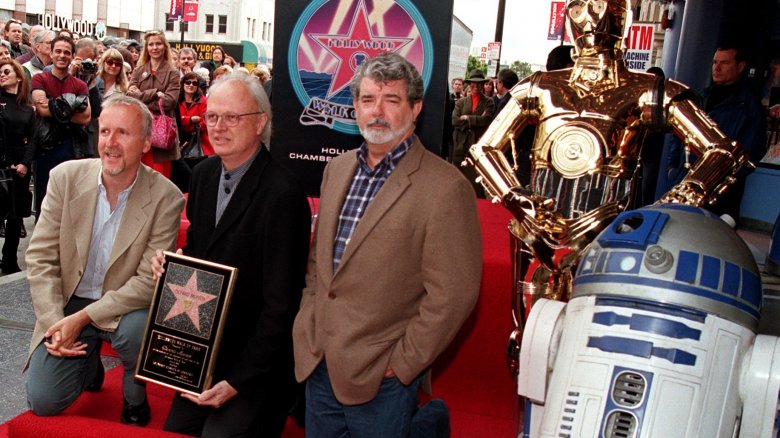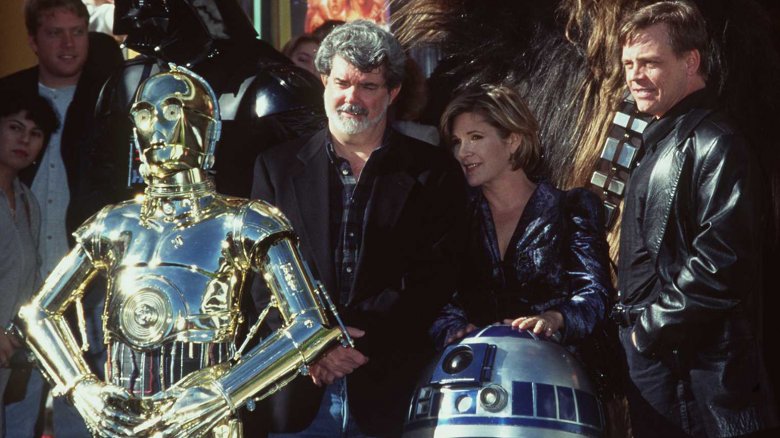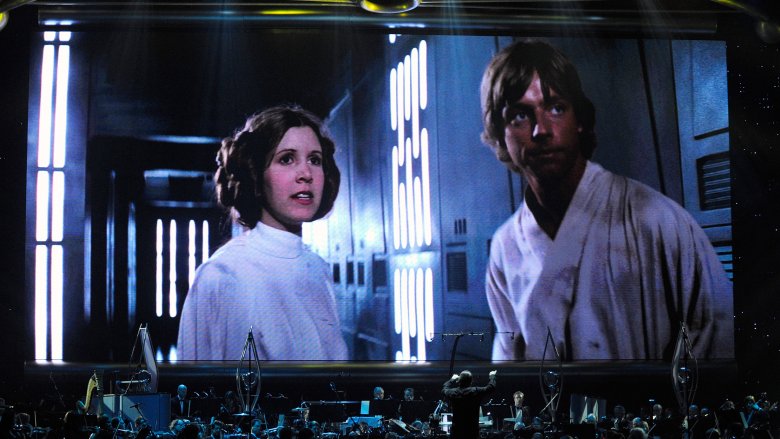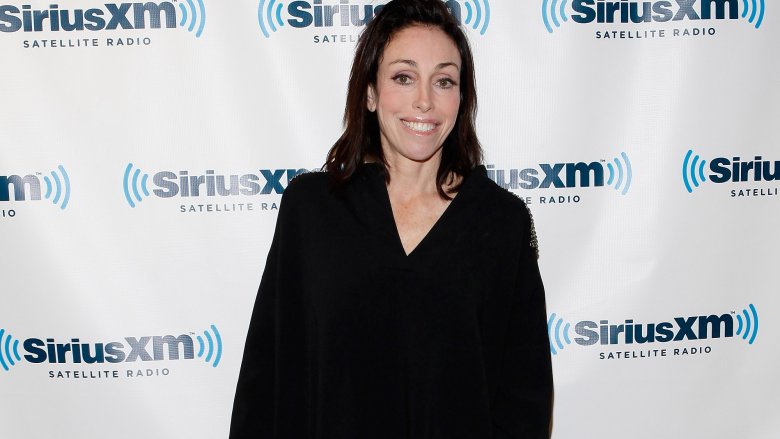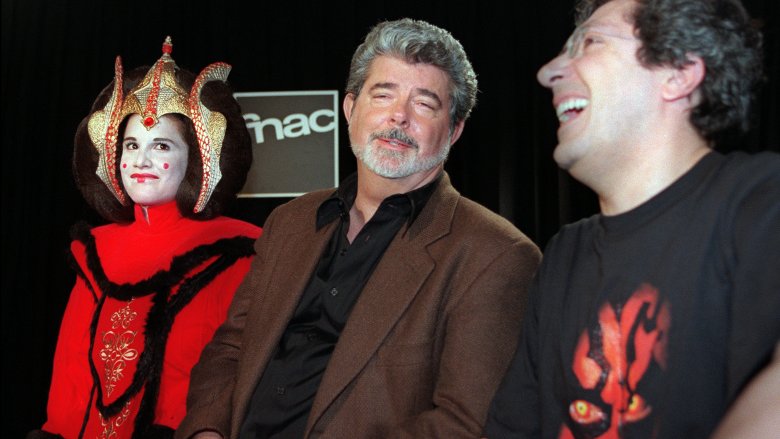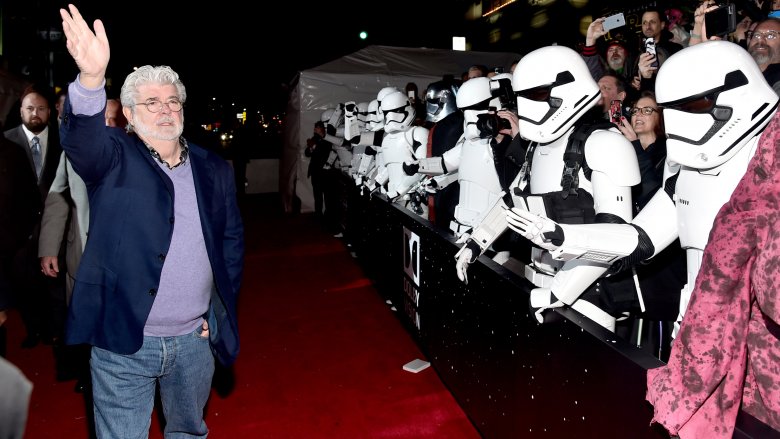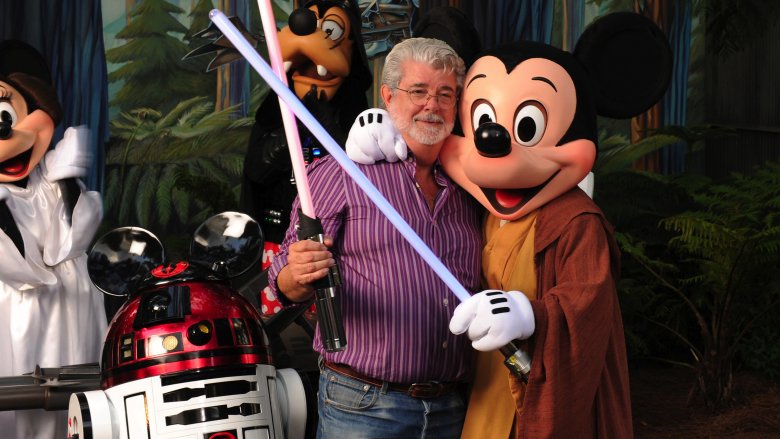Sketchy Things Everyone Just Ignores About George Lucas
Most people would probably agree that Star Wars is one of the most popular and iconic film franchises of the past 40 years. Its success propelled George Lucas from indie filmmaker to practically megastar status in the world of Hollywood, with some help along the way from Lucas' involvement with Indiana Jones, another beloved film series that helped define the '80s. But despite Lucas' reputation as a dominating creative force, his rise to billion dollar success didn't come without some questionable moves that tend to get pushed under the rug.
Star Wars borrowed heavily from a Japanese samurai movie
While Lucas is rightly considered to be the creator of Star Wars, and there's no doubt that his imagination brought audiences an intergalactic epic rich with classic characters, both the original and prequel trilogies are heavily based on the 1958 Japanese samurai film The Hidden Fortress directed by Akira Kurosawa.
"There is the corpulent slave owner who could be a cousin of Jabba the Hutt; there are the mossy forests which anticipate the Ewoks' Endor; and there are the horizontal wipes which both directors use to transition between scenes," writes the BBC. "And if you've ever been bemused by the utter pointlessness of Queen Amidala disguising herself as her handmaid in The Phantom Menace, you can trace her subterfuge back to Princess Uki pretending to be a mute commoner so that she can travel undetected through enemy territory. Besides, can it really be a coincidence that at the end of The Hidden Fortress, the heroes are saved by a facially scarred villain who has a last-minute change of allegiance, much like Darth Vader in Return of the Jedi?"
And while it's sketchy that Star Wars isn't 100% Lucas' creation, he's never shied away from listing Kurosawa as an inspiration. According to People, Lucas even went so far as to use his Star Wars clout to convince 20th Century Fox to finance one of Kurosawa's films when the original studio pulled out. Which is much better treatment than another creative force behind Star Wars received.
You never hear about his ex-wife Marcia Lucas
As far as visual effects go, Lucas and his team at Industrial Light & Magic have been on the cutting edge even when using miniatures and makeshift sets to bring the original Star Wars trilogy to life. But what's hardly mentioned is the woman who not only saved the first film's more personal and memorable moments, but also edited it into the classic that's captivated fans for generations. That woman? Lucas' ex-wife, Marcia.
"Marcia was ... responsible for arguably the most iconic sequence of the film: the trench run. According to Kaminski, the original run was scripted entirely differently, with Luke having two runs at the exhaust port," Australia's News.com reports while citing The Secret History of Star Wars by author Michael Kaminski. "She warned George, 'If the audience doesn't cheer when Han Solo comes in at the last second in the Millennium Falcon to help Luke when he's being chased by Darth Vader, the picture doesn't work.'"
In an interview with Film Freak Central, Luke Skywalker himself called Marcia "the warmth and the heart of those films," and cites her as what's missing from the prequel trilogy. But as The Secret History of Star Wars theorizes, following the divorce, Marica became "the forgotten Lucas" who is conveniently missing from behind-the-scene photos as her contributions to the classic films were "downplayed."
His divorce made The Temple of Doom a tad too dark
If you want an idea how well Lucas was handling the divorce from Marcia, look no further than Indiana Jones and the Temple of Doom, the sequel (well, technically prequel) to the smash hit Raiders of the Lost Ark. In the film, Harrison Ford's swashbuckling archaeologist faces off with villains who scarf down monkey brains and literally rip beating hearts out of men's chests. It was an overly dark turn for the franchise, and according to an appropriately titled Grantland article called "Temple of Gloom," Lucas and his Indiana Jones collaborator Steven Spielberg were not in the best mindsets.
"I was going through a divorce," Lucas explains, "and I was in a really bad mood. So I really wanted to do dark. And Steve then broke up with his girlfriend, and so he was sort of into it, too. That's where we were at that point in time."
If you were a child of the '80s and wonder why you saw a dude's heart get ripped out in an Indiana Jones movie, that would be Lucas and Spielberg inflicting their romantic pain on audiences in not the most subtle of ways. You're welcome?
He was obsessed with underwear in space
Despite being clearly attached to his ex-wife Marcia, Lucas had a strange obsession with how underwear would work in space because he was a little too prepared to explain to a young Carrie Fisher why she couldn't wear a bra while filming Star Wars. (Yeah, we thought that was weird, too.) And the explanation clearly left its mark on Fisher who went so far as to include specific instructions in her obituary regarding Lucas' comments, according to her memoirs Wishful Drinking.
"What happens is you go to space and you become weightless. So far so good, right?" Variety quotes Fisher writing. "But then your body expands??? But your bra doesn't—so you get strangled by your own bra. Now I think that this would make for a fantastic obit—so I tell my younger friends that no matter how I go, I want it reported that I drowned in moonlight, strangled by my own bra."
However, Lucas would apparently change his tune in Return of the Jedi, which featured a gold bikini-clad Fisher next to Jabba The Hutt. And she wasn't exactly thrilled.
The Slave Leia Bikini
Princess Leia's bikini in Return of the Jedi became such an iconic image that it even has its own Wikipedia page. However, Fisher's relationship with the bikini has evolved over the years, but not without moments of her trademark wit like when she offered a hilarious explanation for an outraged father who didn't know what to tell his daughter about the "scandalous" figure at Target.
But in her final book The Princess Diarist, Fisher expressed discomfort with Lucas making her appear in the outfit. According to The Telegraph, she even suggested that early sketches of the costume were meant to "frighten me into exercise" and made sure to emphasize that it was not her choice to wear it.
In the end, and true to her fiery, outspoken spirit, Fisher would make sure that future Star Wars actresses wouldn't suffer the same bikini-clad fate by imparting some words of wisdom to The Force Awakens star Daisy Ridley in Interview magazine. "You should fight for your outfit. Don't be a slave like I was," Fisher said. "You keep fighting against that slave outfit."
He's really obsessed with Howard the Duck
Before making Star Wars, Lucas really wanted to make a film based on Marvel's Howard the Duck, and not surprisingly, studios weren't willing to bite on an adaptation on an obscure comic book about a talking space duck. However, after Star Wars, Lucas could pretty much make whatever he wanted, and got to work executive producing the biggest bomb of his career. Turns out, even in the '80s, audiences weren't exactly ready for a weird, walking duck puppet acting all kinds of pervy around the mom from Back To The Future. Plus the movie was pretty bad.
On the heels of the infamous Princess Leia bikini, Howard the Duck offered another interesting glimpse into what kind of entertainment Lucas enjoys. It also makes a remark about Lucas by his longtime friend John Milius in the documentary Easy Riders, Raging Bulls all the more revealing. "According to Milius, Lucas had already figured out that he'd missed a trick by going into feature film directing," Cinemablend writes. "Instead, Lucas believed that he should have gone into 'porno.'" Whoa! Not what you expected to hear about one of the nerdiest filmmakers in Hollywood, huh?
But there's one more twist, ABC News reports that Howard the Duck bombing would force a cash-strapped Lucas to sell the computer division of Lucasfilm to Steve Jobs, and that's how Pixar was born. Thanks, George Lucas' obsession with an alien duck!
His name is allegedly in Heidi Fleiss' infamous black book
In 2016, another incident would portray Lucas in a more "adult" light after the publication of Hollywood madam Heidi Fleiss' infamous black book allegedly included the Star Wars creator's name alongside such bad boys as Nicolas Cage, Sean Penn, Johnny Depp, and Charlie Sheen.
However, according to Radar who published the findings, Lucas' name allegedly appearing in Fleiss' book is not proof of anything. "There is NO SUGGESTION any of these men procured call-girls from Fleiss — however their names appear in her private journal that is floating around the shadowy underbelly of Hollywood, and has seen by multiple Radar investigators."
Is this making your childhood feel weird? We're sorry. Let's talk about Willow.
Willow was basically a remake of Star Wars
In 1988, an original story by Lucas called Willow hit theaters and became a cult classic despite only performing modestly at the box-office. However, many were quick to notice the movie followed the events of Star Wars: A New Hope just a little too closely.
"Madmartigan (Kilmer) was clearly borne from the same 'Devilish Rogue' mold that cast Han Solo." Birth. Movies. Death. writes. "Willow (Davis) is the slightly-too-whiny-for-his-own-good stand-in for Luke Skywalker. The rough-and-tumble female lead, Sorsha (played by Whalley, and revealed in the film's tie-in novelization to be a princess), is basically just Leia with a broadsword. These characters are joined by a pair of comic relief sidekicks (Franjean and Rool), friends who constantly bicker just like C-3PO and R2-D2. There's sorcerers (Jedis) using magic (The Force), a mentor who trains the hero to use that power himself, and an evil fascist (Bavmorda/Darth Vader) to contend with."
Yikes! On top of blatantly aping Star Wars, there's also been an internet urban legend that Lucas was denied the rights to The Hobbit, so he came up with Willow, which shares numerous similarities to Lord of the Rings. Granted, this theory has never been corroborated, but just like Star Wars was "inspired" by The Hidden Fortress, it's hard to deny the influences from Tolkien's classic series in Willow.
The Phantom Menace used racist stereotypes
When The Prequel Trilogy was first announced, Star Wars fandom lost its mind. But then The Phantom Menace hit theaters, and while it was a box-office success, fans and critics who grew up loving Star Wars couldn't help but notice that something was off. Particularly the inclusion of alien characters who speak with distinct accents that are not the best.
"Crafty Japanese trade villains aren't the only heavy-handed ethnic stereotype in The Phantom Menace," writes Slate. "As the story continues, the heroes slip past the evil Japanese to a nearby planet. There, they attempt to repair their broken spaceship but are stymied by the hook-nosed owner of the local parts shop – Watto – who also happens to have a thick Yiddish accent!"
Making matters worse is the controversial character Jar Jar Binks who many perceived as an unfortunate stereotype of African-Americans, according to Boston Review. But Gen Pop podcast host David Chen would put the matter more succinctly. "What we allow our children to watch matters. When they see The Phantom Menace, which features the triumph of (mostly) white characters over those people with the weird accents who talk, dress, and act differently than "us," what message does it send them?" But good luck telling Lucas that.
He doesn't take criticism well
As criticism about the racial stereotypes in The Phantom Menace continue to grow, Lucas became increasingly defensive to the point where he began lashing out at critics and essentially calling them all stupid.
"Most of them that I've met are reasonably dim-witted," Lucas told Salon in 2000. "I mean, they aren't like the rest of us. They don't have any knowledge of anything. They're not successful in any world that I've ... They certainly don't know anything about history; they don't know anything about film. They don't know anything about politics. They don't know anything about sociology or psychology or anything. I mean, it's like, you get into a conversation with them and it's hard to find a subject that they can actually converse on."
Ouch. But even more concerning is that, according to Salon, Lucas thinks nobody would've cared about the offensive stereotypes in The Phantom Menace had one Los Angeles Times writer not brought it up, which is obviously not the case. Then again, he actually thinks of himself as a king/despot that no one should question.
He thinks despotism is great
In a 1999 interview with the New York Times leading up to the release of The Phantom Menace, Lucas made an odd remark about that spoke fondly about how the United States would be better off with a king or even a despot. Wow, okay.
"Now, obviously, in some cases it got used in a wrong way and you ended up with the whole balance of power out of whack. But there's probably no better form of government than a good despot." Lucas said. When asked if that's what's he trying to be at Lucasfilm, he responded. "Possibly. Yeah, at least in my little kingdom."
Not surprisingly, Lucas would later answer that he doesn't think the media should call out a pretty good leader who's doing some shady things. "I think that the media should look at the situation in the larger sense—at what is necessary for the culture as a whole rather than exposing and tearing everything down all the time. That will not bode well for people's confidence in the institution. After all, a society only works on faith. If you lose that faith, then your society will crumble and it will be hard to get a consensus on anything." For the record, Lucas just described Communist Russia as an ideal template for society. And it wouldn't be the first time Lucas would go to extremes after not receiving the respect he feels he deserves.
He called Disney white slavers after they bought Star Wars
When Disney purchased Lucasfilm in 2012 for a whopping $4 billion, it became a pop culture phenomenon as the House of Mouse simultaneously announced that there would be new Star Wars movies starting with Episode VII, which became the smash hit The Force Awakens. However, behind the scenes, Disney's relationship with Lucas soured as it decided to not use his outlines for the new trilogy and didn't want him involved, presumably to avoid the same fate as the prequels. This prompted Lucas to use some choice words during an interview with Charlie Rose.
"I sold them to the white slavers that takes these things," Lucas bluntly said, according to Pajiba. "They looked at the stories, and they said, 'We want to make something for the fans.' They decided they didn't want to use those stories, they decided they were going to do their own thing. ... They weren't that keen to have me involved anyway."
To Lucas' credit, he admitted to Rose that he would've been a problem because of his control freak tendencies, and he apologized to Disney in a statement to The Hollywood Reporter. "I misspoke and used a very inappropriate analogy, and for that I apologize. I have been working with Disney for 40 years and chose them as the custodians of Star Wars because of my great respect for the company and Bob Iger's leadership."
George Lucas is a genius, but he isn't perfect
Despite his sketchy behavior and a strong aversion to accepting criticism, Lucas created one of the most lush, imaginative science fiction properties of all time that's captivated fans of every race, gender, and age for generations. He also brought audiences Indiana Jones, which became a beloved classic for millions. Not to mention, his work with visual effects would lay the groundwork for everything from Pixar to the Marvel movies. He's undoubtedly one of Hollywood's great visionaries, and who knows what he could accomplish if he learns to take a little criticism and learns it's not all about George?

